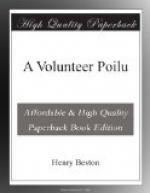“I heard somebody yell.”
“Where?”
“Over there by that stump.”
We strained our ears to catch a sound, but heard nothing.
“I heard the yell plainly,” replied the sentry.
The news seemed to give some satisfaction. At any rate, the Germans stopped their trench shells. The quiet hush of late afternoon was at hand. Soon the cook came down the trench with kettles of hot soup.
Five months have passed since I last saw the inhabitants of this abri, the tenants of the “Ritz-Marmite.” How many are still alive? What has happened to this fine, brave crowd of Frenchmen, gentlemen all, bons camarades? I have seen them on guard in a heavy winter snowstorm, when the enemy was throwing grenades which, exploding, blew purplish-black smudges on the snow; I have seen them so bemired in mud and slop that they looked like effigies of brownish earth; I have watched them wading through communication trenches that were veritable canals. And this is the third year of the war.
The most interesting of the lot mentally was a young Socialist named Hippolyte. He was a sous-lieutenant of the Engineers, and had quarters of his own in the rear of the trenches, where one was always sure to find books on social questions lying round in the hay. When the war began he was just finishing his law course at the University of Montpellier. A true son of the South, he was dark, short, but well proportioned, with small hands and feet. The distinguishing features of his countenance were his eyes and mouth—the eyes, eloquent, alert, almost Italian; the mouth, full, firm, and dogmatic. The great orators of the Midi must have resembled him in their youth. He was a Socialist and a pacifist a outrance, continuing his dream of universal fraternity in the midst of war. His work lay in building a tunnel under the Germans, by which he hoped to blow part of the German trenches, Teutons and all, sky-high.
The tunnei (sape) began in the third line, at a door hi the wall of the trench strongly framed in wooden beams the size of railroad ties. At occasional intervals along the passage the roof was reinforced by a frame of these beams, so that the sape had the businesslike, professional look of a gallery in a coal mine. Descending steeply to a point twelve feet beyond the entrance, it then went at a gentle incline under No Man’s Land, and ended beneath the German trenches. It was the original intention to blow up part of the German first line, but it being one day discovered that the Germans were building a tunnel parallel to the French one, it was decided to blow up the French safe so that the explosion would spend its force underground, and cause the walls of the German tunnel to cave in on its makers. I happened to see the tunnel the morning of the day it was blown up. The French had stopped working for fear of being overheard by the Germans. It was a ticklish situation. Were the Germans aware of the French tunnel? If so, they would blow up their own at once. Were they still continuing their labor? The earth of the French might burst apart anyminute and rain down again in a dreadful shower of clods, stones, and mangled bodies.




